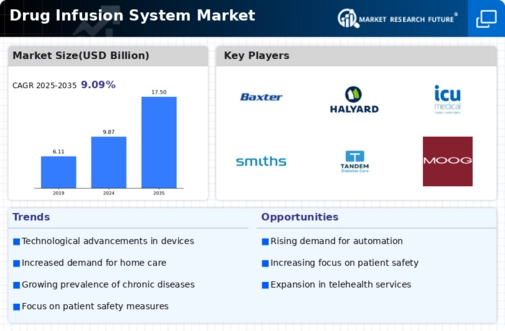Rising Prevalence of Chronic Diseases
The Global Drug Infusion System Market Industry is experiencing growth driven by the increasing prevalence of chronic diseases such as diabetes, cancer, and cardiovascular disorders. As these conditions require long-term medication management, infusion systems become essential for delivering precise dosages. For instance, diabetes management often necessitates continuous insulin infusion, which can be effectively managed through advanced drug infusion systems. The rising number of patients with chronic illnesses is projected to escalate the demand for these systems, contributing to the market's valuation of 9.87 USD Billion in 2024 and a potential increase to 17.5 USD Billion by 2035.
Regulatory Support and Standardization
Regulatory support and standardization play a pivotal role in shaping the Global Drug Infusion System Market Industry. Governments and health organizations are establishing guidelines and regulations to ensure the safety and efficacy of drug infusion systems. This regulatory framework fosters innovation while ensuring that manufacturers adhere to high-quality standards. Additionally, standardization of infusion practices across healthcare settings enhances patient safety and treatment outcomes. As regulatory bodies continue to support the development and implementation of advanced infusion technologies, the market is likely to experience sustained growth, aligning with the increasing demand for reliable healthcare solutions.
Growing Demand for Home Healthcare Solutions
The Global Drug Infusion System Market Industry is witnessing a shift towards home healthcare solutions, driven by the rising preference for at-home treatment options among patients. This trend is particularly evident in the management of chronic diseases, where patients seek to minimize hospital visits. Infusion systems designed for home use offer convenience and flexibility, allowing patients to receive necessary medications in a comfortable environment. This growing demand is likely to propel the market forward, as more healthcare providers adopt these systems to cater to patient needs, thereby contributing to the projected market growth.
Technological Advancements in Infusion Systems
Technological innovations in drug infusion systems are significantly influencing the Global Drug Infusion System Market Industry. The introduction of smart infusion pumps, which utilize advanced algorithms for dosage calculations and monitoring, enhances patient safety and treatment efficacy. These systems can integrate with electronic health records, allowing for real-time data tracking and management. Such advancements not only improve clinical outcomes but also streamline healthcare workflows. As a result, the market is expected to grow at a CAGR of 5.32% from 2025 to 2035, reflecting the increasing adoption of these sophisticated technologies in healthcare settings.
Increasing Investment in Healthcare Infrastructure
Investment in healthcare infrastructure is a crucial driver for the Global Drug Infusion System Market Industry. Governments and private entities are increasingly allocating funds to enhance healthcare facilities and improve patient care services. This investment often includes the procurement of advanced drug infusion systems, which are vital for modern healthcare delivery. Enhanced infrastructure not only facilitates better access to infusion therapies but also ensures that healthcare providers can meet the rising demand for these systems. As a result, the market is expected to benefit from this trend, further solidifying its growth trajectory.

















